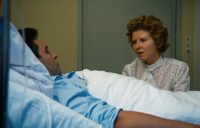
Newsletter August 2020

In May, the New York Times published an appreciation of twelve “great” TV series made by film directors. The list includes David Lynch’s TWIN PEAKS, Jane Campion’s TOP OF THE LAKE, Nicolas Winding Refn’s TOO OLD TO DIE YOUNG, and – in first place – Fassbinder’s BERLIN ALEXANDERPLATZ.
The author of the piece, Scott Tobias, described the series, which RWF actually regarded as an extended cine film, as “a difficult and confrontational work by any standard, much less broadcast television, with […] a style that is murky and experimental. But it also forced a German audience to once again reckon with life in the Weimar Republic and the conditions that gave rise to the country’s darkest chapter.” The full article can be found at: https://nyti.ms/3jcy3Ce EN
For readers in the USA and Canada the “film” can be found, for example, on the Criterion Channel: https://www.criterionchannel.com/berlin-alexanderplatz/season:1 EN
In the wake of Fassbinder’s birthday on 31 May, a further significant birthday for fans of German cinema will soon be upon us. Born in the same year as RWF, Wim Wenders will turn 75 on 14 August. To mark this anniversary the archive of the German broadcaster ARD is making many of the director’s works available free of charge. The selection includes the documentary CHAMBRE 666, in which Wenders talks with a number of directors about the future of film during the Cannes Film Festival in 1982. Along with Werner Herzog, Susan Seidelman, Yilmaz Güney and Monte Hellman, Fassbinder also took part in Wenders’ film. One month later he was dead. The film will be available on ARD until 14 September: https://bit.ly/3gsttO8 DE
Only a few days before Fassbinder’s birthday, we received the sad news that Irm Hermann had died at the age of the 77. Although she almost always played small roles for RWF, her portrayal of venomous members of the lower middle class remain unforgettable. In her obituary for the actress, Christine Dössel attempted to capture the Hermann’s particular visual presence on screen: “The puppet-like stiffness of her acting, the displayed immobility, often accompanied by a malicious grin, became Irm Hermann’s trademark. Added to this was her explicit way of talking, which sounded like an artificial language.” The entire text can be found on the website of the Süddeutsche Zeitung: https://bit.ly/2Eoisk7 DE
In his tribute in DIE ZEIT Georg Seeßlen describes Hermann as “one of German cinema’s fascinating non-actors,” characterizing her style as a “particular form of abstraction”: “Words came out of her like something alien that one assimilated with great effort and great resistance, and her body moved as if it was accustomed quite literally to offend. A character that did not belong but was not about to let this fact destroy her.” The complete text can be found at: https://bit.ly/3gnjKZv DE
The stage designer Anna Viebrock, who worked with Hermann on many productions directed by Christoph Marthaler, recalls an inquisitive and fearless woman who in the course of her life slowly broke free. In addition, in an interview recorded for the radio broadcaster Deutschlandfunk Kultur, Viebrock reveals the name of Hermann’s favorite Fassbinder film. The conversation is available at: https://bit.ly/32s1ucu DE
Although Hermann was happy to talk about her time with Fassbinder, she certainly did not lack offers from other directors as well. She worked with Werner Herzog and Ulrike Ottinger, showed off her comic side with Loriot and Herbert Achternbusch, and from the 1990s onwards appeared in many of the films and plays directed by Christoph Schlingensief. On 20 August the release of Bettina Böhler’s documentary SCHLINGENSIEF – A VOICE THAT SHOOK THE SILENCE in German cinemas will give audiences the opportunity to see Irm Hermann on the big screen once again. A trailer for the film can be viewed at: https://bit.ly/3aSoghw DE
Another member of Fassbinder’s circle, Peter Gauhe, also passed away recently. In a contribution to the blog of the German Film Museum (DFF), Hans-Peter Reichmann recalls a quiet man, one “of the many who are active in the background.” Gauhe played small roles in films such as FONTANE EFFI BRIEST and ALI: FEAR EATS THE SOUL but was known above all as a set photographer. Between 1969 and 1974, he documented many Fassbinder film shoots, in the process creating some of the iconic pictures we have of the director. A selection of his work can be found at: https://www.dff.film/peter-gauhe/ DE
As we enter our summer break, we wish our readers and friends all the very best. We will be back in October with more news from the world of Rainer Werner Fassbinder.
More on the films of Rainer Werner Fassbinder:
http://www.fassbinderfoundation.de/filme-von-fassbinder/ DE
http://www.fassbinderfoundation.de/filme-von-fassbinder/?lang=en EN
http://www.fassbinderfoundation.de/filme-von-fassbinder/?lang=fr FR
Photo left: Irm Hermann in “Händler der vier Jahreszeiten” © RWFF/ Photographer: Peter Gauhe
Photo right: “Händler der vier Jahreszeiten” © RWFF/ Photographer: Peter Gauhe